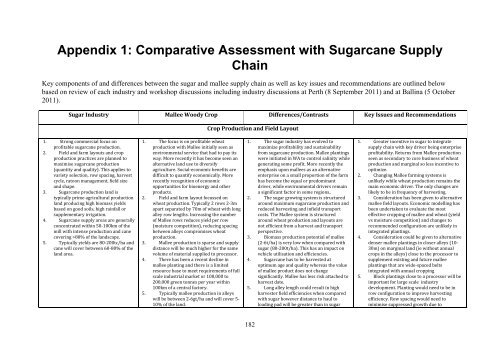Download (4Mb) - USQ ePrints - University of Southern Queensland
Download (4Mb) - USQ ePrints - University of Southern Queensland
Download (4Mb) - USQ ePrints - University of Southern Queensland
Create successful ePaper yourself
Turn your PDF publications into a flip-book with our unique Google optimized e-Paper software.
Appendix 1: Comparative Assessment with Sugarcane Supply<br />
Chain<br />
Key components <strong>of</strong> and differences between the sugar and mallee supply chain as well as key issues and recommendations are outlined below<br />
based on review <strong>of</strong> each industry and workshop discussions including industry discussions at Perth (8 September 2011) and at Ballina (5 October<br />
2011).<br />
Sugar Industry Mallee Woody Crop Differences/Contrasts Key Issues and Recommendations<br />
Crop Production and Field Layout<br />
1. Strong commercial focus on<br />
pr<strong>of</strong>itable sugarcane production.<br />
2. Field and farm layouts and crop<br />
production practices are planned to<br />
maximise sugarcane production<br />
(quantity and quality). This applies to<br />
variety selection, row spacing, harvest<br />
cycle, ratoon management, field size<br />
and shape.<br />
3. Sugarcane production land is<br />
typically prime agricultural production<br />
land producing high biomass yields<br />
based on good soils, high rainfall or<br />
supplementary irrigation.<br />
4. Sugarcane supply areas are generally<br />
concentrated within 50-100km <strong>of</strong> the<br />
mill with intense production and cane<br />
covering >80% <strong>of</strong> the landscape.<br />
5. Typically yields are 80-200tc/ha and<br />
cane will cover between 60-80% <strong>of</strong> the<br />
land area.<br />
1. The focus is on pr<strong>of</strong>itable wheat<br />
production with Mallee initially seen as<br />
environmental service that had to pay its<br />
way. More recently it has become seen an<br />
alternative land use to diversify<br />
agriculture. Social-economic benefits are<br />
difficult to quantify economically. More<br />
recently recognition <strong>of</strong> economic<br />
opportunities for bioenergy and other<br />
products.<br />
2. Field and farm layout focussed on<br />
wheat production. Typically 2 rows 2-3m<br />
apart separated by 70m <strong>of</strong> wheat with long<br />
alley row lengths. Increasing the number<br />
<strong>of</strong> Mallee rows reduces yield per row<br />
(moisture competition), reducing spacing<br />
between alleys compromises wheat<br />
production.<br />
3. Mallee production is sparse and supply<br />
distance will be much higher for the same<br />
volume <strong>of</strong> material supplied to processor.<br />
4. There has been a recent decline in<br />
mallee planting and there is a limited<br />
resource base to meet requirements <strong>of</strong> full<br />
scale industrial market or 100,000 to<br />
200,000 green tonnes per year within<br />
100km <strong>of</strong> a central factory.<br />
5. Typically mallee production in alleys<br />
will be between 2-6gt/ha and will cover 5-<br />
10% <strong>of</strong> the land.<br />
1. The sugar industry has evolved to<br />
maximize pr<strong>of</strong>itability and sustainability<br />
from sugarcane production. Mallee plantings<br />
were initiated in WA to control salinity while<br />
generating some pr<strong>of</strong>it. More recently the<br />
emphasis upon mallees as an alternative<br />
enterprise on a small proportion <strong>of</strong> the farm<br />
has become the equal or predominant<br />
driver, while environmental drivers remain<br />
a significant factor in some regions..<br />
2. The sugar growing system is structured<br />
around maximum sugarcane production and<br />
reduced harvesting and infield transport<br />
costs. The Mallee system is structured<br />
around wheat production and layouts are<br />
not efficient from a harvest and transport<br />
perspective.<br />
3. Biomass production potential <strong>of</strong> mallee<br />
(2-6t/ha) is very low when compared with<br />
sugar (80-200t/ha). This has an impact on<br />
vehicle utilisation and efficiencies.<br />
4. Sugarcane has to be harvested at<br />
optimum age and quality whereas the value<br />
<strong>of</strong> mallee product does not change<br />
significantly. Mallee has less risk attached to<br />
harvest date.<br />
5. Long alley length could result in high<br />
harvester field efficiencies when compared<br />
with sugar however distance to haul to<br />
loading pad will be greater than in sugar<br />
1. Greater incentive in sugar to integrate<br />
supply chain with key driver being enterprise<br />
pr<strong>of</strong>itability. Returns from Mallee production<br />
seen as secondary to core business <strong>of</strong> wheat<br />
production and marginal so less incentive to<br />
optimize.<br />
2. Changing Mallee farming systems is<br />
unlikely while wheat production remains the<br />
main economic driver. The only changes are<br />
likely to be in frequency <strong>of</strong> harvesting.<br />
3. Consideration has been given to alternative<br />
mallee field layouts. Economic modelling has<br />
been undertaken to evaluate the most<br />
effective cropping <strong>of</strong> mallee and wheat (yield<br />
vs moisture competition) and changes to<br />
recommended configuration are unlikely in<br />
integrated plantings.<br />
4. Consideration could be given to alternative<br />
denser mallee plantings in closer alleys (10-<br />
30m) on marginal land (ie without annual<br />
crops in the alleys) close to the processor to<br />
supplement existing and future mallee<br />
plantings that are wide-spaced belts<br />
integrated with annual cropping<br />
5. Block plantings close to a processor will be<br />
important for large scale industry<br />
development. Planting would need to be in<br />
row configuration to improve harvesting<br />
efficiency. Row spacing would need to<br />
minimise suppressed growth due to<br />
182
















